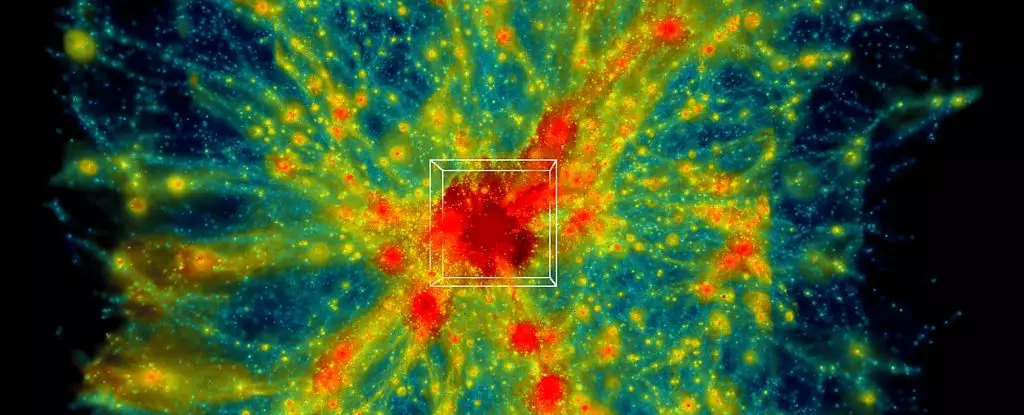In a remarkable leap for astrophysics, a team of physicists at Oak Ridge National Laboratory (ORNL) has achieved an unprecedented milestone with the ExaSky simulation, marking the largest astrophysical simulation to date. This monumental project employed the power of the Frontier supercomputer, utilizing a staggering 9,000 computing nodes to explore a section of the Universe that measures over 31 billion cubic megaparsecs. The implications of this endeavor are far-reaching, promising to deepen our understanding of cosmic evolution and the intricate nature of dark matter.
While the quantum world presents complexities in itself, the vast tapestry of the Universe introduces even manifold challenges. Dark matter, which interacts primarily through gravitational forces, coexists with conventional atomic matter. According to physicist Salman Habib from Argonne National Laboratory, comprehending the Universe’s intricacies demands simulations that encompass both gravity and the myriad other components at play, including the behaviors of hot gases and the processes that lead to star and galaxy formation. These comprehensive simulations aim to recreate a “kitchen sink” of astrophysical phenomena, ultimately building a clearer depiction of cosmic dynamics.
Astrophysicists have always been fascinated by the concept that gazing into the cosmos equates to peering into a time machine, allowing them to witness the evolution of the Universe across vast stretches of time. However, the enormity of cosmic timescales presents a unique problem: the development of cosmic structures occurs over periods that are incredibly protracted compared to human timescales. Therefore, these simulations are indispensable. They allow scientists to manipulate variables, accelerating or reversing time while zooming in and out of cosmic snapshots, thus enabling a more comprehensive investigation into how the Universe has evolved over billions of years.
Yet the simplicity of this manipulation belies a more complex reality. The Universe is staggeringly intricate, necessitating sophisticated mathematical frameworks and colossal computing capabilities. Historically, simulations have had to forgo some variables due to the sheer complexity involved. Habib emphasizes that prior simulations often only approximated gravity, omitting critical elements needed for a holistic approach. The limitations posed by computational technology have restricted astrophysical endeavors, confining them to gravity-centric models until very recently.
Fundamentally, the advances in computational power have significantly transformed how scientists can simulate cosmic phenomena. The ExaSky project has been years in the making, shaped by tireless refinement of algorithms and enhancements to the Hardware/Hybrid Accelerated Cosmology Code that enables such simulations. With the Frontier supercomputer now recognized as the fastest of its kind globally, researchers were finally able to expand the scale of their simulations to authentically represent the Universe’s expansion.
It is vital to acknowledge that the simulation executed represents only a minuscule fraction—roughly 0.001 percent—of the entire cosmic volume ordained for study. However, Bronson Messer, an astrophysicist at ORNL, suggests that the sheer breadth of the simulated domain is crucial for directly comparing theoretical results to modern survey observations, thus establishing a more solid footing for future astronomical research.
The trajectory towards understanding the cosmos is not solely based on observational data; theoretical simulations like ExaSky are equally essential in piecing together the cosmic puzzle. As researchers scrutinize the data produced by this gargantuan simulation, they anticipate revelations that may reshape current models of the Universe. These breakthroughs could significantly enhance our insights into dark matter’s elusive nature while expanding our grasp of the forces that have shaped the cosmic landscape over eons.
As ExaSky continues to unveil the mysteries of the Universe, it reflects an era of accelerated discovery made possible by sophisticated technology and innovative minds. The work conducted at ORNL and its contribution to astrophysics speaks to the larger narrative of humanity’s quest to understand its place in the cosmos, hinting at the astronomical advancements that lie ahead. Indeed, as we delve deeper into the mysteries of dark matter and cosmic evolution, we may find ourselves teetering on the brink of a new understanding of the cosmos, one simulation at a time.

